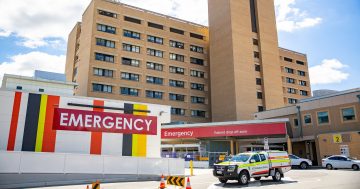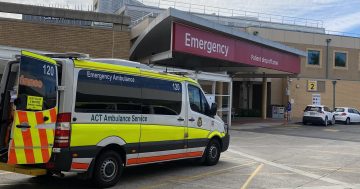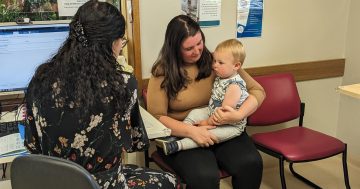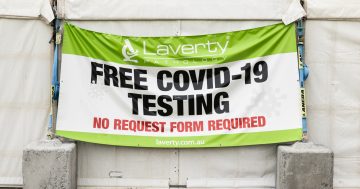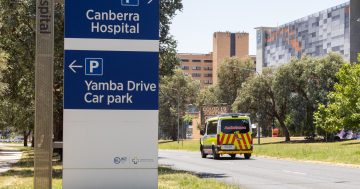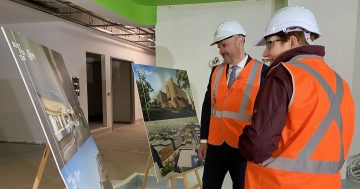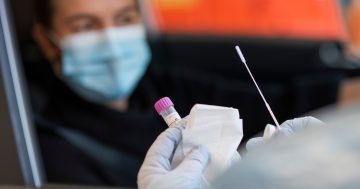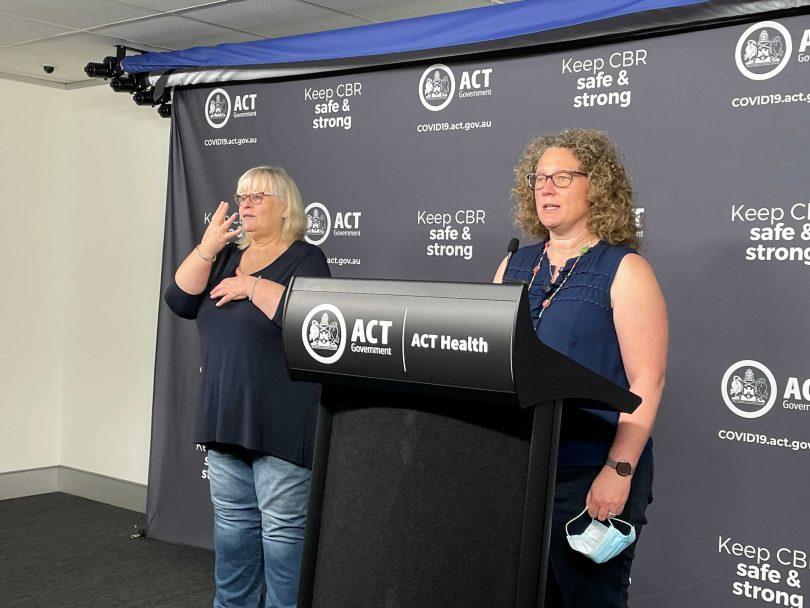
Dr Kerryn Coleman at today’s COVID-19 briefing: “One high number on its own does not necessarily mean … our system is not working.” Photo: Dominic Giannini.
UPDATED 2:30 pm: There is still no clear path out of Canberra’s lockdown three weeks into the hardline restrictions and two weeks before its scheduled end, with Chief Minister Andrew Barr saying it was too early to make any predictions about when the ACT’s outbreak would peak.
The ACT recorded 32 new cases today (4 September), only eight of which were isolated during the entirety of their infectious period.
Chief Health Officer Dr Kerryn Coleman said that the record number of cases today could be indicative of a number of different things and health authorities were still working through what the new cases meant for the Territory.
“While it is concerning, one high number on its own does not necessarily mean we will continue this trend upwards or that our system is not working,” she said.
“Our numbers will continue to fluctuate whilst there is transmission in our community. But what is really important is our ability to link these cases and our ability to identify any potential for ongoing transmission or exposure to enable us to interrupt [this].”
A total of 37 cases in the current outbreak remain unlinked, including five from today where investigations were in their preliminary phase.
Mr Barr said the Territory was not anticipating the outbreak to worsen based on the available data, caseloads and the effective reproductive rate.
“The difference for [the ACT compared to NSW and Victoria] is that our effective reproduction rate – that is the number of people each new case infects on average – is less than one,” he said.
“It is not just the daily case numbers that are the important [statistics], it also includes … the risk associated with those who were infectious in the community, as in how many days and what the nature of their community engagement was.
“Our outbreak is being controlled and slowly reducing. NSW and Victoria both have effective reproductive rates above one.”
Mr Barr noted that while the ACT recorded 32 new cases overnight, almost 50 people recovered from the virus, meaning the number of active cases actually dropped.
But despite constant references to some level of public health restrictions in place after the ACT’s lockdown and before the Territory reaches an adequate level of vaccinations, Mr Barr said it was still too early to provide a roadmap about what restrictions would look like over the coming months.
When asked whether some sort of stay at home orders would form the bedrock of restrictions, Mr Barr said he did not want to ease restrictions too early and risk worsening the outbreak, which would force the ACT to snap back into a lockdown.
“That is not where anyone wants to be. I want to be able to take good meaningful steps forward over the next few months as we continue to vaccinate,” he said.
“That really is contingent upon continuing to vaccinate at an accelerated rate; effective test, trace, isolate and quarantine; and having some continuing public health measures in place.
“I appreciate that everyone wants to know exact dates, but unfortunately the pandemic does not respond to … desires to be able to give an exact date on everything. It is a constant moving feast of challenges.”
The national plan includes some level of restrictions above the 70 and 80 per cent vaccination threshold, the detail of which is yet to be finalised. The ACT is due to have 80 per cent of its population vaccinated by mid-November, and three weeks would need to be added to that date to account for the vaccine’s efficacy period, Mr Barr said.
The ACT Government continues to consider ways to increase the Territory’s vaccination rate – which is due to surpass 70 per cent of first doses for people above the age of 16 this weekend – including the possibility of bringing forward the second dose of AstraZeneca.
In the meantime, public health restrictions will remain in place to mitigate risk.
“The purpose of the lockdown, the masks and the physical distancing is to have a range of other public health measures that protect against the risk associated with people being infectious in the community,” he said.
“All of those measures, together with the increased vaccination rate help, but they do not completely eliminate the risk.”
The government is also considering including children above 12 into the vaccination targets, given that Moderna and Pfizer have been approved for use in the cohort.
This would increase the population that the vaccination targets are based on by about 20,000 to 25,000 in the ACT but would only push back the ACT’s scheduled date of hitting the vaccination thresholds by two to three weeks, Mr Barr said.
“It is worth spending those few weeks vaccinating those teenagers,” he said. “It is a very worthy public health goal.”
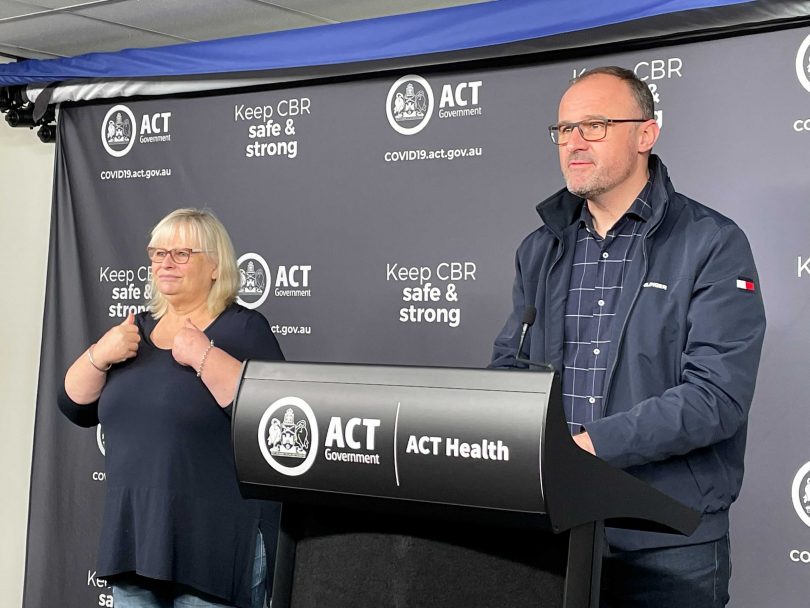
Chief Minister Andrew Barr at this morning’s COVID-19 briefing. Photo: Dominic Giannini.
12.30 pm: There are 32 new cases of COVID-19 overnight, the highest total yet recorded in the ACT’s outbreak.
Only eight were in quarantine for their full infectious period, while 19 were infectious in the community. Twenty-four are linked to known cases or sites and half the new cases are household contacts.
“Daily numbers can be volatile. These headline numbers are not what we wanted today,” Chief Minister Andrew Barr told today’s press briefing.
“The number of people infectious in the community is obviously very concerning. Our contact tracers will have a very busy weekend ahead of them.”
Mr Barr said it was too early to predict the outbreak’s future, but the ACT’s position was considerably different from the NSW and Victorian outbreaks. He said it was still possible for this outbreak to be contained although the ACT remains at high risk from another incursion.
“The difference for us is our effective reproduction rate is less than one. Our outbreak is being controlled and slowly reducing. NSW and Victoria both have effective reproduction rates above one, so each new case infects more than one other person,” Mr Barr said.
“We would not anticipate, based on our current case load and effective reproduction rate, to see our outbreak worsen on today’s available data.”
He urged people to get vaccinated, with a reminder that AstraZeneca is available on a walk-in basis. Anyone with even the mildest symptoms is being strongly urged to come forward for testing and everyone should follow public health directions, including wearing properly fitted masks.
Around 2500 tests were carried out yesterday. Given today’s weather, some outdoor pop-up clinics will have to close today. Details are available via the ACT Health Facebook page.
Chief Health Officer Dr Kerryn Coleman said that the outbreak now totals 359 cases. A total of 120 cases have now recovered.
“I know [32 new cases] is a high number, our single highest number in a 24-hour period”, she said, adding that it could be “a fair bit of work” to analyse these cases.
“While it is concerning, one high number on its own doesn’t necessarily mean we will continue the trend upwards or the system isn’t working. Numbers will fluctuate but our ability to link and quickly identify ongoing transmission and exposure risks is the critical thing,” she said.
Of the total 359 cases, health authorities are confident they know the source of 314 cases while 37 remain unlinked.
Ten people are hospitalised with two in intensive care and one ventilated. The youngest patient is under 16 years, the oldest is 54.
There are now more than 250 active exposure locations with more to come later today as the new cases are traced. There are 14 public transmission sites although Dr Coleman said the primary case for some clusters may never be identified, particularly as time passes.
“I cannot stress enough that if you return a positive result, you and everyone else in your household must quarantine,” Dr Coleman said.
People in quarantine cannot leave the house to exercise, shop, work, go to school or receive visitors.
Health Minister Rachel Stephen-Smith said a large number of people were now being cared for at home across the ACT with 24/7 access to nurses and doctors, including paediatric clinicians. If required this can escalate to hospital-at-home care before people need to be admitted to hospital.
She urged people not to go to work if they have even the mildest symptoms.
“You may be right that you just have a cold … but your test may come back positive,” she said.
“By going and getting tested you have prevented your workmates taking the disease home to their households and their families. This is not the time to make that decision to go to work.”
As the AIS hub begins mass vaccination, the ACT will receive an additional 86,797 Pfizer doses from the Commonwealth’s swap with the United Kingdom. This allocation balances out jurisdictions that didn’t receive a per capita share of the deals with Poland and Singapore. Most will go to GPs and pharmacies.
The Moderna vaccine has now been approved by the Therapeutic Goods Administration and will be available for people 12 years and older by the end of September. Mr Barr said he is now “very confident” that the ACT will get to 80 per cent of the population being double vaccinated.
The Chief Minister appealed to Canberrans to do the right thing as some restrictions ease slightly.
“We will constantly review the level of risk to our community. We know lockdown is hard”.
He said the easing would give those who are struggling the chance to see others in a low-risk setting, but they were not intended for people to go out and mix with as many people as possible.
11:50 am: The ACT has recorded 32 new COVID-19 cases to 8:00 pm last night.
At his daily COVID-19 briefing, Chief Minister Andrew Barr said 24 cases are linked to current or identified close contacts, but only eight were in quarantine for the entirety of their infectious period.
Nineteen spent part of their infectious period in the community and five are under investigation.
There are 10 people hospitalised with COVID-19 across the ACT. Two are in intensive care and one requires ventilation.
“These headline numbers are not what we wanted today,” Mr Barr said.
NSW has reported another record number of cases -1533 – and four deaths to 8:00 pm last night.
Victoria reported 190 locally acquired cases earlier today.
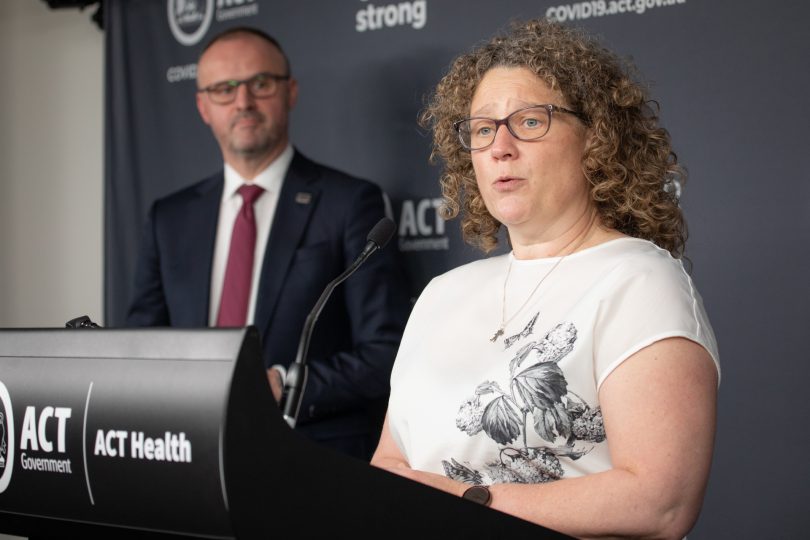
ACT Chief Health Officer Dr Kerryn Coleman wants testing numbers to increase. Photo: Michelle Kroll.
9:50 am: ACT Health is reminding Canberrans to get tested if they have been identified as a close or casual contact or have developed any symptoms of COVID-19, including fever, cough, sore throat, shortness of breath, or a loss of smell or taste.
There were 2500 tests in the 24 hours to yesterday’s press conference, a number Chief Minister Andrew Barr said was not enough with cases continuing to increase.
Only three of yesterday’s 18 cases were in quarantine during the entirety of their infectious period.
There are now almost 300 active exposure locations across Canberra as of last night (3 September) after the addition of a number of stores across Dickson, the city and Fyshwick.
Anyone who was at Woolworths Dickson between 1:45 pm and 2:40 pm on Wednesday (1 September) is considered a casual contact, as is anyone who attended the Emart Asian Supermarket in the city between 1:20 pm and 2:45 pm on Monday (30 August).
ALDI Gungahlin has also been listed as a casual exposure location between 6:40 pm and 7:40 pm on Sunday, 29 August.
Anyone at BWS and Dan Murphy in Dickson between 5:10 pm and 6:00 pm and 5:45 pm and 6:30 pm respectively are being told to monitor for symptoms.
Visitors to the Canberra Centre between 11:30 am and 7:30 pm on Monday, 30 August is also being told to monitor for symptoms, as is anyone who attended a number of shops at the Fyshwick Fresh Food Markets between 10:20 and 12:00 pm on Sunday, 29 August.
A full list of exposure locations can be found at covid19.act.gov.au.
Chief Minister Andrew Barr, Health Minister Rachel Stephen-Smith and Chief Health Officer Dr Kerryn Coleman will provide an update at 11:45 am.
More to come.












